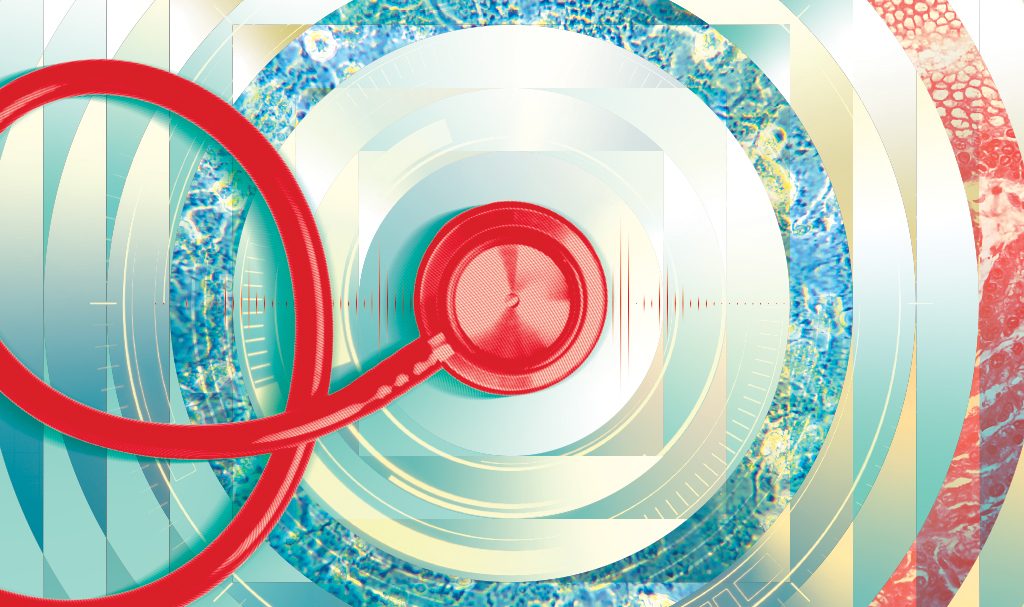
AsianScientist (Apr. 24, 2024) – For seasoned scientists, it often takes one look at an experimental cohort, whether through microscopic images or a series of electrical waves, to pick apart alterations
from the norm. In the clinic, physicians can quickly combine information from a battery of tests to spot signs of disease and deliver an accurate diagnosis.
Their uncanny ability to distinguish healthy from sick can be attributed to years of practice, training and extensive experience with analyzing biological samples.
Inspired by the human mind’s capacity for learning, artificial intelligence (AI) models are first trained on existing datasets so that they can recognize patterns and apply the same rules to new samples. This opens avenues for various healthcare applications, like detecting diseases early or making predictions about responses to treatment.
As straightforward as the process may sound, the training phase is typically a gargantuan task, especially considering the variability between individuals and their possible symptoms. High-performance computing (HPC) could be the key to unlocking this bottleneck, offering massive computing power that enables the processing of multitudes of clinical data in a short time span.
By synergizing HPC and AI resources, scientists and physicians can hope to make sense of complex biological phenomena more rapidly and accurately.
A shorter route to drug development
From antibiotic pills to anti-inflammatory ointments, the wonders of modern medicine are perhaps best encapsulated by the spectrum of drugs lining pharmacy shelves. Many previously untreatable diseases can now be addressed by several different therapies, yet many more represent persisting clinical gaps—urgently needing the development of more effective interventions.
But before any drug can be approved for clinical practice, it must first undergo thorough evaluation to demonstrate its medical benefits and outline any potential side effects. This journey of drug discovery and development is often tedious: starting from identifying druggable targets and compounds with possible pharmacological activities, followed by several rounds of testing from cell cultures to pre-clinical models to human clinical trials.
“Drugs are very expensive to develop and the entire process can take 10 to 15 years,” said Professor Satoshi Matsuoka, Director of the RIKEN Center for Computational Science. “One way for costs to go down is by introducing automation and shortening the development cycle.”
Innovations in HPC and AI are in prime position to accelerate the drug development pipeline, without cutting corners nor compromising safety. One of the most critical aspects of synthesizing these compounds lies in performing molecular dynamics simulations, which model atomic motions, interactions and overall conformational changes over time.
Whether through anesthetics that block off pain sensations or carcinogenic agents that trigger several pathways to drive cell proliferation, biomolecules exert their effects primarily by interacting with others. They can have multiple binding sites and various interaction partners, with the nature of such activities changing depending on the molecule’s structure and environmental conditions. Even a small alteration in their structure—and by extension, the genetic code that contains the instructions for producing these molecules—could bring about massive consequences for their functionality.
Thanks to their impressive capacity for running numerous simulations, AI algorithms can help scientists search for candidate drug compounds, discover novel drug targets, delineate their structures, and predict the biochemical interactions between these molecules and the human body. Adding HPC into the mix is akin to shifting into second gear: enabling larger scale, higher quality and much faster simulations to be performed in parallel.
To this end, Taiwan Web Service Corporation (TWSC), a subsidiary of multinational computer hardware company ASUS, has been making significant strides toward building high precision and seamless workflows for the biomedical sector, backed by HPC and deep learning.
“We have incorporated AI applications into the entire biomedical engineering process to meet the needs of data processing, AI biomedical model training and technology tool creation,” said TWSC CEO Peter Wu in a press release.
By integrating the nine-petaFLOPS Taiwania 2 supercomputer with an optimized GPU framework from NVIDIA, the team is driving the intelligent transformation of various biomedical applications, including bioinformatics analysis and medical imaging.
Forgoing the need for complex programming skills, their OneAI no-code development platform makes secondary gene analysis more easily accessible, enabling users to hunt for potential genomic variants of medical relevance. By leveraging the efficient GPU processing of NVIDIA Parabricks to analyze such complex data, TWSC’s AI supercomputer is 80 times faster than traditional CPU solutions and cuts computational costs in half. The NVIDIA Clara for Drug Discovery deep learning algorithms further bolster these endeavors, performing molecular dynamics simulations and protein structure prediction to accelerate the development of new drugs.
Generating drug candidates
In another collaborative effort, NVIDIA and Japanese corporation Mitsui
have joined forces for the Tokyo-1 project, using NVIDIA’s HPC resources for molecular dynamics and generative AI (GenAI) models. The NVIDIA DGX system features dual x86 CPUs and eight H100 Tensor Core GPUs, with each contributing 32 petaFLOPS of computing power to take on massive workloads such as running large language models (LLMs) involving millions of parameters.
LLMs may seem like a misnomer, having surged to popular consciousness particularly through ChatGPT. However, language is not limited to human speech and can also encompass the language of biochemistry. One’s DNA is essentially a string of chemicals that can be represented by a “letter” code, as can the RNA and protein sequences derived from these genetic instructions.
With this standardized biological manual, molecular structures are
consistent in the ways they respond to compounds, set signaling pathways into motion and more. Discovering patterns in these sequences through LLMs can effectively associate yet-untested compounds with certain properties, ranging from targeted drug delivery to immune activation.
Based on these patterns, GenAI can also be used to design novel molecular structures as possible therapies. Scientists can draw inspiration from receptor conformations on viruses or tumor cells to tweak drug compounds and improve their efficacy and safety profiles.
In South Korea, for example, researchers from the Daegu Gyeongbuk Institute of Science & Technology are maximizing such HPC-enabled creative capabilities to explore new candidate proteins for infectious diseases and neurological disorders. Comprising a cluster of V100-GPU cores, their high-performance supercomputing facility expedited the design of a drug to target Interleukin-1 receptor antagonist, which is a key regulator of immunity and inflammation.
Upon testing in the lab using cellular assays, the team found that their designer antiinflammatory drug showed strikingly better performance than an approved COVID-19 medication, Anakinra. With the first phase of the development process already complete, trials using in vivo pre-clinical models are next on the horizon.
At RIKEN, the AI/HPC pharmaceutical division is also developing a sophisticated platform to span drug discovery until validation, in partnership with several pharmaceutical companies.
“It is not just a single probe or single software,” Matsuoka explained. “The pipeline involves over 50 components, combining software programs, databases and AI algorithms, to generate drug candidates and run simulations to validate the effectiveness of the candidate versus potential dangers.”
A new generation of digital diagnostics
Just as predicting molecular interactions is no easy feat, evaluating a person’s risk for developing disorders is similarly a challenging undertaking.
When assessing heart disease risk, for example, cardiologists must take into account a spectrum of factors, such as age, cholesterol levels and symptoms of chest pain. Co-morbidities like diabetes as well as lifestyle habits like smoking and lack of exercise also contribute to this risk score.
“In general, physicians can roughly predict disease risk, but the accuracy margin is wide,” said Clinical Professor Yeo Khung Keong, CEO and Senior Consultant at the National Heart Centre Singapore, as well as the Academic Chair of the SingHealth Duke-NUS Cardiovascular Sciences Academic Clinical Programme.
At SingHealth, the recently launched AI for the Transformation of Medicine program is poised to bridge this gap, accelerating innovations in smart healthcare through HPC technologies. The Singapore General Hospital campus houses SingHealth’s first-ever supercomputer, CHROMA, which is dedicated to processing vast amounts of clinical data and training Al models for biomedical applications.
Jointly developed with the National Supercomputing Centre Singapore, CHROMA is equipped with 1,024 CPU cores and an NVIDIA DGX 320 GB AI accelerator, and is envisioned to facilitate the development of Al models that can predict disease risk and patient trajectories, as well as support health workers in delivering better care to those most in need.
CHROMA is already making waves in the cardiovascular field, as it is being used to train an Al model that can assess a person’s risk for a serious cardiac event such as a heart attack. The project, dubbed APOLLO, is a collaboration between the National Heart Centre Singapore at SingHealth; the Agency for Science, Technology and Research; Duke-NUS Medical School; National University Hospital; and Tan Tock Seng Hospital.
“[CHROMA and the new innovation center] will catalyze new partnerships
between innovators and industry partners, generate new ideas, prototypes and smart technologies for better disease prevention, diagnoses and treatment,” said Professor Ivy Ng, who has since stepped down as Group CEO of SingHealth, in a press release.
Once trained, the AI tool will be able to analyze CT scans of the heart’s vessels to detect narrowing and plaque build-up, which are critical signs that a person may be at risk for developing cardiovascular disease or experiencing
a cardiac event in the future. What makes HPC-enabled AI particularly
powerful is the possibility to combine different data types, Yeo noted.
For example, the model could learn to take into account other possible biomarkers including the fatty acid composition of the plaques or data from wearables like the heart rate measured by smart watches, especially contextualized to Asian populations. Moreover, CHROMA on its own can shorten the training phase to just one to two months, compared to the half-year it would typically take.
“What AI brings to the table is reducing the variability between assessing risk scores and increasing the speed of getting the reports,” said Yeo. “We want highly reproducible and consistent tools to raise the accuracy of diagnostics.”
These risk assessments can then help guide clinical decision-making,
triaging patients with cardiovascular disease and prioritizing those at
high risk for serious cardiac events. The APOLLO team envisions that the integration of such technology in the healthcare workflow can lead to better allocation of hospital resources and the timely delivery of potentially life-saving interventions.
Through AI-powered image analytics, digital pathology solutions are also set to revolutionize cancer detection. Typically, tissue samples from patients are laid on microscopy slides for seasoned pathologists to carefully scrutinize under a microscope. However, tiny cancer cells are not easily recognizable, complicating doctors’ efforts to diagnose and assess disease prognosis.
To empower physicians and patients alike, Microsoft and AI company
Paige are embarking on a visionary collaboration to develop an image-based GenAI platform that would act as a highly sensitive radar system to spot these malignant cells.
By providing clinical-grade AI and driving the digitalization of modern
pathology, the project has the potential to significantly enhance the accuracy and efficiency of clinical oncology work—ultimately enabling precision diagnosis and improving patient outcomes.
Impact and integration
With a vision to build healthier communities, a growing number of countries and institutions are investing in supercomputing resources for biomedical purposes. As HPC-powered healthcare applications pick up speed, it is only a matter of time before these endeavors lead to tangible outcomes for patients.
However, achieving such real-world impact will hinge upon not just technological advancements, but also intentionality and governance over their use. Considering the sensitivity of medical information, Yeo emphasized that regulatory frameworks and practical guidelines must also adapt and evolve alongside these innovations.
“We can aim for integrating AI in healthcare, but because these technologies would affect lives, there must be safeguards and enough evidence that prove their efficacy and safety,” he said.
Accordingly, research teams are incorporating additional security features and privacy-preserving techniques into their workflows, highlighted Matsuoka. Federated learning is one way to keep local databases separate and inaccessible from other users, while still maximizing the efficiency of the model training process on a global server.
Ensuring ethical use and building trust will become important facets to get physicians and patients on board when it comes to integrating novel technologies in the healthcare system.
When anchored on the values of responsible tech, HPC-enabled AI innovations have the power to transform the future of data-driven and needs-based smart medicine—ranging from the lab-centered beginnings of drug discovery, to the ripples of social impact brought about by enhanced diagnostics and clinical care delivery.
“The biggest thing is to integrate AI technologies into our regular workflows so that we hardly even notice it,” said Yeo. “Whether it’s making clinical decisions, monitoring health and alerting patients to warning signs, or predicting outcomes in real-time, supercomputing capabilities would be tremendously important for delivering appropriate medical interventions on an individual level.”
—
This article was first published in the print version of Supercomputing Asia, January 2024.
Click here to subscribe to Asian Scientist Magazine in print.
Copyright: Asian Scientist Magazine.
Disclaimer: This article does not necessarily reflect the views of AsianScientist or its staff.












